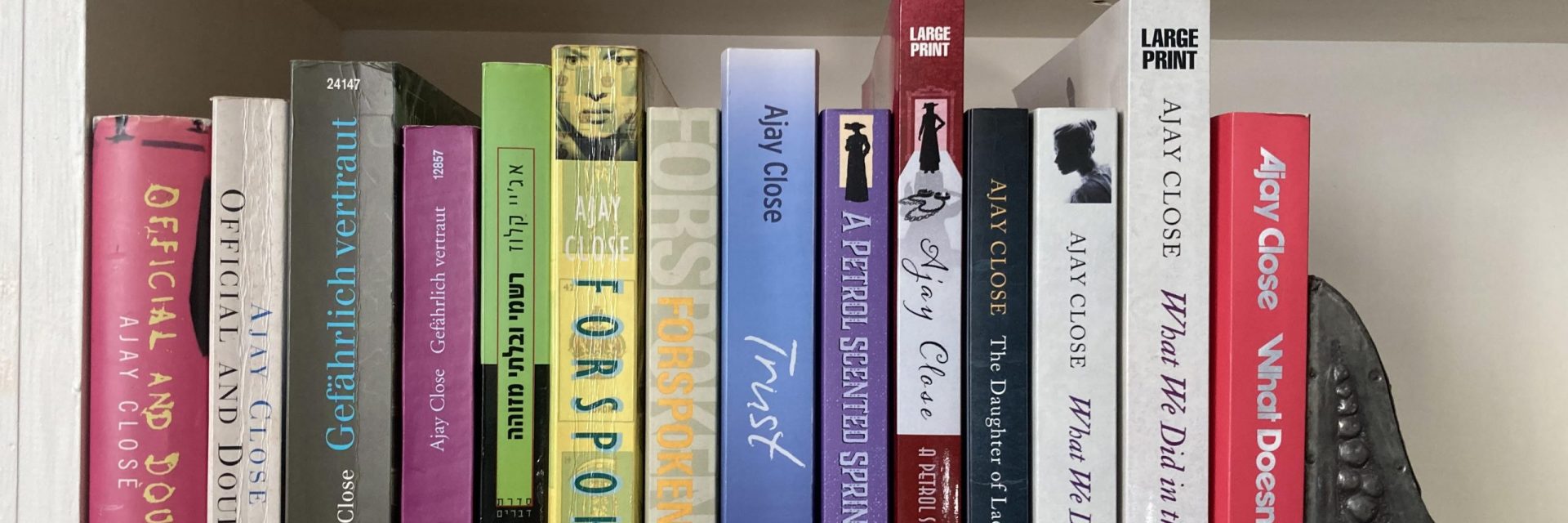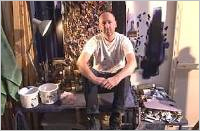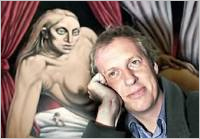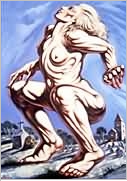
September 23, 2000
There are two standard responses to Hugh Collins: liberal-sentimental and vengeful-cynical. We have seen plenty of both since his release from jail seven years ago. Gangland murderers are good copy whether you believe in the perfectibility of the soul or in leopards who don’t change their spots. The problem with all these profiles, features and interviews is that they are not really about him. The same questions get asked – why did he do it? Is he sorry? Has he really changed? – and he returns the same answers. But once you get past the journalist’s moral tub-thumping, there is precious little sense of the man. So why not take a less high-minded approach, address a different question: what’s it like to spend the afternoon with a killer?
Like surfing a tsunami. For three and a half hours words fire out of him at ultra-high speed. Sometimes I manage to get a question in, sometimes he even answers it, but mostly the monologue goes its own way: razor gangs, drugs, protection rackets, the five attempted murders they couldn’t make stick, the dungeon in Perth prison, the three screws he stabbed, the Barlinnie Special Unit, Jimmy Boyle and, inevitably, the killing of Willie Mooney. He says he is nervous but it is I who end up shaking uncontrollably, the teeth rattling in my head. I blame the restaurant’s punishingly efficient air-conditioning, but it’s something else too. A combination of empathy and alienation. I think the phrase is weirded out.
The thing about Collins is he wants to make an impact, to be admired – and maybe a little feared. His conversation is peppered with threats to third parties: this or that foe he could put in a bin bag. It’s rubbish, of course. As a murderer released on a life licence, he would be back inside so fast his feet wouldn’t touch the ground.
But still he talks the talk. He grew up in the Garngad in Glasgow, a culture steeped in the king-of-the-dunghill bravado of the hard man. Then there’s the other side of him: the searching gaze of the man who craves understanding, the candour nurtured by the Special Unit and his friendships in the Edinburgh arts world. It sounds like Jekyll and Hyde, but in Collins the contradictions are merely expressions of a single urge for contact, a need to get under the barriers.
This may explain why it is difficult to describe him. I can give you first impressions: the high colouring, the pewter hair, that seven-inch cleaver scar biting deep into his jaw line… but very quickly these details cease to register. He has the knack of making those around him see the world through his eyes.
Does this sound cosy? Believe me, it is not. He describes himself as neurotic, obsessive. He takes panic attacks. But still he puts himself on show. Any man who claims he doesn’t like being looked at is a liar, he says; twice. One of his favourite words is “glamour”. He is living his own legend, and for the next six hours I have no choice but to live it too. Glasgow becomes a village with Armani-suited gangsters on every street corner; Edinburgh, a hamlet in which the pin-striped establishment is up to its neck in conspiracies and cover-ups. Yes, I know, you’ve heard it all before, but in Collins’s mouth the clichés come to life. Walking up the High Street with him is like stepping into a film, vivid and slightly alarming. Faces swim in and out of focus. Some shake my hand. There is a sense of event I don’t quite understand until he complains that he is pestered by bampots wanting to be seen with him. For all his talk of vanishing to a cottage in the middle of nowhere, he enjoys holding court.
In Walking Away, the second volume of his autobiography, he describes the weeks after his release from prison in 1993. He is living in a room in Edinburgh’s 369 Gallery with his girlfriend (now his wife) the artist Caroline McNairn, and spending his nights at an endless round of parties and exhibition openings. He is flat broke but there always seems to be a glass of Champagne to hand. One opening is held in a church, a beautiful woman strips naked, another appears at the altar strapped-up with a dildo. He gets drunk with Russian artists, shakes hands with the Leader of the Opposition, discovers how deliciously sexy the word “fuck” sounds on the lips of a titled lady, titillates a roomful of gay men with tales of prison life.
The vengeful-cynical brigade see Collins as the pet monster of “Edinburgh café society”, but then Edinburgh café society is itself pretty monstrous, at least as it appears in Collins’s book: a magnet for exotics and grotesques. He likes celebrity, famous names, bright plumage. He’s proud of his connections with Jim Kelman and Irvine Welsh. Ask him about the night he stalked Ruby Wax at the New Yorker party. Will Self was there, and Martin Amis. He met Salman Rushdie, told him there were a couple of Arab guys outside looking for him…
By this time we’re in his flat, high above the Edinburgh rooftops. “A view with a room,” he calls it. Battered sofas and ottomans heaped with cushions, ethnic and oriental rugs layered over the floor, paintings covering every inch of wall. We could be back in the 1950s, in the Edinburgh of Anne Redpath and Robin Philipson. Gradually I stop shivering, thanks to the two-bar electric fire, a steaming mug of tea, and the steadying influence of Caroline McNairn.
Collins met McNairn when he was still in prison but working on day-release at the 369 Gallery. He remembers standing at the sink outside her studio, running cups under the tap until his fingers were like prunes, just so he could bump into her (“oh hello”) when she stepped into the corridor. They married shortly after he got out of jail. Their backgrounds could not be more different: she is middle-class, from an artistic family in the Borders. She put up with a lot at the beginning. He was drinking heavily, panicking at freedom after 16 years behind bars, trying to get into fights with bouncers, smashing things up. She physically restrained him, and got flung against a window for her pains. She’s no masochist, and took no pleasure in his violent past. A woman with a weaker streak of liberal idealism might have given up on him but, seven years on, they’re still together.
She is wary of discussing the relationship. Once couples start talking about their love the divorce papers are never far behind, she says. But there’s an obvious warmth between them. It seems an easy partnership, with plenty of space. She talks, he interrupts her, she reminds him that she hadn’t finished. He covers his sharp shirt with a baggy jumper, puts on a pair of glasses and calms down. He’s still talking 19 to the dozen but it’s now a conversation. I almost stop feeling alienated.
One of our dominant fantasies about rehabilitated murderers is the idea of the clean break: a new life, away from the background that shaped them. But it is not easy living without the past. Notwithstanding his artist wife, his bookish friends, his reputation as a sculptor, his writing career, Collins misses his old pals. He goes through to Glasgow to see them at the boxing. They sit at the Shamrock table (named after his old gang). “They’re not criminals, they’re just guys ducking and diving.” He takes some trouble to find a poster of three men posing with Mike Tyson at his recent fight in Glasgow. He points to the one on the right. “That’s Albert,” he says.
Albert and Shooey were as close as brothers in boyhood. They were in the Shamrock together, and spent some time in Manchester, shoplifting to order. There they had a falling out. The next three years saw an escalating sequence of tit-for-tat violence involving razors, cleavers, crossbows and shotguns. Albert was jailed for 12 years for a bank robbery but the feud continued. One day in 1977 Collins had a tip-off that Albert’s friends were planning to take him to a party, spike his drink with acid and fling him out of the high flats. Coincidentally (such was the routine violence of those times) he had an appointment to “go for a walk” with an old prison acquaintance, Willie Mooney, the same night. Mooney had growled at Collins’s 14-year-old nephew and honour had to be satisfied. Collins walked into the Lunar Seven pub and found Mooney with Albert’s pals. Fighting broke out and Mooney ended up dead. Collins went berserk and savaged him.
“In that world he wasn’t a bad guy. He was kind of half-cut that day and I just exploded in his face. That’s the side of it I’m ashamed of.”
It was not until two years ago, at his da’s funeral, that Collins met up with Albert again. Both of them had changed. Albert’s a legitimate businessman now and bears no grudge. Collins was profoundly touched by their reconciliation. “I feel more comfortable with him than with anybody I know – I feel I’ve went hame.” Over the course of the afternoon he brings the conversation back to Albert again and again. He talks about coming full-circle. It is almost as if he is trying to undo the events that led up to Mooney’s death.
It is a psychological commonplace that we go through life looking to recreate our earliest relationships. In Collins’s case these were the formidable but loving grandmother he lived with (his mother was only an intermittent presence) and the glamorous father with the film-star looks and hard-man reputation who spent long periods in jail. The five-year-old Hugh stood up in class and announced that his da was a bank robber, a Robin Hood figure. He still hasn’t got over being disillusioned.
He hates men, he says, and men’s company, the nonsense they talk: “‘I’ve fired a gun, I’ve stabbed somebody’ – Jesus Christ… ” As a boy he wanted to be a priest or to play for Celtic. “But when these things start to fall through everybody wants an identity of some kind.” By the age of 21 he was running a protection racket involving every pub on Sauchiehall Street and Buchanan Street. The gangs in Pollok, Paisley, Possilpark, Maryhill, were a joke; whoever dominated the city centre was top dog. That was him: he ran the toon.
He hates men, and yet he is one of them. He is forever trying to square this circle, to find a way of enjoying the respect of men without the violence that underpins so many masculine pecking orders. He takes particular men as models, investing enormous trust and admiration. Albert is the most conspicuous example, but the list also includes his editor Kevin Williamson and the socialist MSP Tommy Sheridan. In the Special Unit his mentor was Jimmy Boyle.
In the first volume of his memoirs, Autobiography of a Murderer, he expresses irritation that, as a fellow sculptor and rehabilitated killer, he will always be seen as following in Boyle’s footsteps; but there is regard and gratitude too. In the new book this ambivalence has become out-and-out loathing. He mocks Boyle’s ideas on deprivation (“a hole in my shoe and I killed a guy”). He is bitter about the fact that Boyle must have admitted his guilt to gain parole, yet publicly maintains his innocence. He believes that, by marrying into money and living the high life as a Champagne importer, Boyle has alienated public sympathy, setting back the cause of other rehabilitated criminals awaiting release. “When I saw him with the Rolls-Royce I thought: that’s five years added onto my sentence.”
His mother became close to Boyle in the Special Unit and has often compared Collins unfavourably. When his father visited the unit he seemed more interested in meeting “Scotland’s most violent man” than in spending time with his son. But when Boyle was released, Collins says his relatives were soon dropped. “I felt he used my whole family, the very people who supported him to get him out of the jail.”
Boyle has branded Collins “damaged goods” and accused him of keeping a foot in both the straight world and the criminal. Collins is enraged by this. “He’s not been tested out here. He’s surrounded himself with people who haven’t challenged him. I’ve been challenged: the art world is a heavy place. He was wrapped up in cotton wool in the Special Unit, he walked out to wealth. I’ve lived in a gallery. I’m under the threat of bankruptcy all the time. I don’t know how long we’ve been on the cream cracker trail: you’re on the dole, you’re off the dole. He’s never faced any of that.” The litany of grievance continues, ending with the claim that Boyle upped the ante for prisoners wanting to start over. “He set standards that every lifer had to marry a millionaire or they were a dead loss.”
Does he not display a pattern of idealising men and then hating them when they fail to live up to his fantasy? He is greatly taken with this theory. “You’ve hit it on the nail about men.” He has done it throughout his life. “I’ve tried to put men that my mother’s had as boyfriends on platforms and then when they fell off I’ve had a big disappointment.” And so it was with Boyle. “He disappointed me, but I put him up into that position.” Not that this insight makes any difference to the hostility he feels. “I’ve got guys saying ‘Do you want us to go through and do him?’. I said: ‘No, please don’t turn him into a fucking martyr. That’s what he wants: St Jimmy’.”
In jail they labelled Hugh Collins a sociopath. He used the tag to bluff the warders. Fear is an emotion he understands. He would confront a fellow con, then inform him “I’ll be back in five minutes.” By the time he returned the terror would have taken hold. “Their legs go like jelly, and you can knock them out.” (Momentarily I feel weird again.) He wasn’t a good fighter when he was younger, but he would use any weapon: chib anybody anywhere. “The crazier you were the bigger the reputation.”
Recently he has read a couple of articles punting the “St Hugh” line. It’s not true. He describes himself as a violent man, present tense. Could he kill again? “I’m much more aware of what’s going on in my brain and what’s inside my emotions.” But he’s still the same guy. “A lot of people aren’t aware of their limitations, their boundaries. They say ‘I would never kill anybody’ but they don’t know. Everybody is capable of killing somebody.”
Maybe if he felt threatened he could lash out, but not in a calculated way. One night a homeless man was trying to break into his flat, kicking at the door. “If I’d’ve had a weapon I might have stabbed him.” (Characteristically, McNairn wanted to ask the guy in for a cup of coffee.) The only answer is to keep well away from weapons. If necessary he falls back on intimidation. People tell him he has frightening eyes. It’s the scars at the outer corners, he says matter-of-factly, looming across to give me a closer look.
He is still angry. He shouts at the television news every night, Caroline has bought him a water pistol to shut him up. He is incensed by the hypocrisy of a government that can bomb children in Iraq for the sake of oil, while locking up men like himself for crimes of violence. He hates the class system, the power of the multinationals. The way he sees it, crime is just another aspect of capitalism. “If I ever went on the rampage again it’d be the multinationals. If I hit 70 they’d better watch out: I’ll be the oldest fucking terrorist in history.”
How do you describe Hugh Collins? Murderer? Former murderer? Socialist? Sociopath? As with the rest of us, it depends to some extent on the company he keeps. Actually, I’d guess, rather more than with the rest of us. So he chooses his friends carefully, stays out of pubs and is working on a disciplined daily routine of t’ai chi and writing, with only the occasional bender. He would like to get back to stone carving, but he’s 50 now: he’s not sure he has the stamina. And he questions his own motives: is it all about being macho…?
By the end of our afternoon together he is good company. Relaxed, amusing, reckless in the details he’s prepared to divulge, slightly vulnerable in his need for human contact. Hardly weird at all. He still feels the pull of reputation: the challenge of running the toon. But as long as his manor is bookish-artistic Edinburgh, that’s not a crime.
Courtesy of Scotsman Publications






